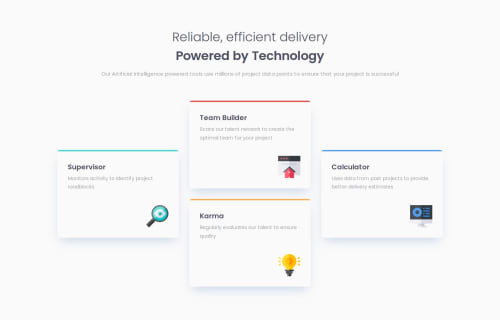Four card feature section using CSS Grid and Flexbox

Solution retrospective
I am particularly proud of how smoothly I was able to implement layout using CSS Grid for the desktop version of my project. The process was surprisingly quick and efficient! Based on feedback from my peers on previous challenges, I made several improvements:
- I replaced
elements withtags to enhance semantic HTML. - I utilised
@font-faceto incorporate custom fonts, reducing reliance on third-party CDNs. - I added a `` description to enhance SEO, which is a crucial aspect of web development that I wanted to prioritise.
- I also remembered to include alt attributes for images this time, which I often forget.
I would focus more on optimising for mobile layouts from the beginning to ensure a seamless experience across all devices.
What challenges did you encounter, and how did you overcome them?I encountered a significant challenge when trying to create a top color border for each card. Initially, I attempted to use border-top, but I noticed that there were slight curves on both the left and right sides, which didn't align with the card's design. To address this, I created a new div called card-line-* and set its height and width accordingly.
However, this approach led to another issue: the card-line-* div was overflowing and not conforming to the card's border-radius. After doing some research online, I discovered the overflow: hidden property, which resolved the issue and allowed the card-line-* to fit perfectly within the card's rounded borders.
I’d love feedback on my code to see how I can improve it, as I always learn something new from the insights I receive.
Please log in to post a comment
Log in with GitHubCommunity feedback
- P@Stroudy
I use this site to get my
.woff2fonts - P@Stroudy
Hey, You smashed this challenge, Incredible work on this! You’re making great strides, and I have a couple of suggestions that might push it even further…
-
Using
font-display: swapin your@font-facerule improves performance by showing fallback text until the custom font loads, preventing a blank screen (flash of invisible text). The downside is a brief flash when the font switches, but it’s usually better than waiting for text to appear. -
I think you can benefit from using a naming convention like BEM (Block, Element, Modifier) is beneficial because it makes your CSS more organized, readable, and easier to maintain. BEM helps you clearly understand the purpose of each class, avoid naming conflicts, and create reusable components, leading to a more scalable codebase. For more details BEM,
-
Using
remoremunits in@mediaqueries is better thanpxbecause they are relative units that adapt to user settings, like their preferred font size. This makes your design more responsive and accessible, ensuring it looks good on different devices and respects user preferences.
@media only screen and (max-width: 1024px) and (min-width: 551px)- It is good to see you hosting your own fonts, Consider hosting fonts in a
.woff2format,.woff2is a highly compressed version of fonts, reducing the file size significantly (up to 30% smaller than WOFF, and much smaller than TTF). This smaller size improves website loading times and reduces bandwidth usage..ttfis better suited for desktop applications or systems that don’t require the same web-specific performance or compression standards.
It is really nice to see you making changes based on my feedback, You’re doing so well, and I hope this feedback is helpful! Keep honing your skills and remember to enjoy the process—you’re on a great path. Stay motivated, and happy coding! 🎯
-
Join our Discord community
Join thousands of Frontend Mentor community members taking the challenges, sharing resources, helping each other, and chatting about all things front-end!
Join our Discord